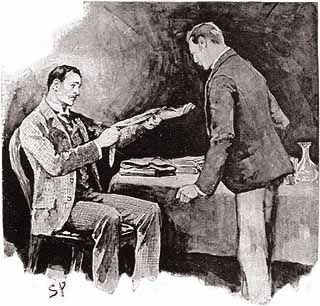 As part of an ongoing project on my Twitter feed, I'm delivering stories from the Sherlock Holmes canon in tiny installments of 140 characters or less. I recently finished up "The Adventure of the Abbey Grange," which finds Sherlock Holmes acting as judge, and Dr. Watson in the role of jury (but the executioner is conspicuously absent).
The current story is "The Engineer's Thumb," which is one of only two cases that Dr. Watson's was able to bring to Sherlock Holmes's attention (the other being the unpublished case of Colonel Warburton's madness).
Check out my Twitter feed for a daily installment, although I am usually inspired to post more than once a day. And don't forget you can read through the original canon online.
As part of an ongoing project on my Twitter feed, I'm delivering stories from the Sherlock Holmes canon in tiny installments of 140 characters or less. I recently finished up "The Adventure of the Abbey Grange," which finds Sherlock Holmes acting as judge, and Dr. Watson in the role of jury (but the executioner is conspicuously absent).
The current story is "The Engineer's Thumb," which is one of only two cases that Dr. Watson's was able to bring to Sherlock Holmes's attention (the other being the unpublished case of Colonel Warburton's madness).
Check out my Twitter feed for a daily installment, although I am usually inspired to post more than once a day. And don't forget you can read through the original canon online.
[As presented at "A Scintillation of Scions V," in Laurel, Md., on June 9, 2012.]
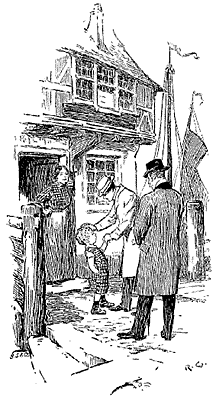 Of all the verbal cleverness in the Canon, of all the subtle
linguistic quips and well-placed witticisms, I am especially fond of one
particular use of the word strategically. “’Dear little chap!’
said Holmes strategically.” This application is from The Sign of Four in which the reader finds Sherlock Holmes seeking information about the steam launch Aurora
and he presents the “dear little chap” with two shillings for seemingly nothing
more than being “a rosy-cheeked young rascal.” The Detective uses young people
– quite often small children – regularly in
the course of his canonical investigations. Information gleaned from young
people was frequently instrumental in providing the solution to more than one
case, but Holmes was also known to use children as actual clues. In “The Copper Beeches,” for example, Holmes
explains how he was able to infer the behavior of Mr. and Mrs. Rucastle by
considering the behavior of the family’s youngest member: “I have frequently
gained my first real insight into the character of parents by studying their
children.” And as Edward Quayle said in his 1948 essay “Suffer the Little
Children,” there are even canonical stories where children act as both clue and contributor: “In The Sussex Vampire a boy was the
miscreant and a baby boy was exhibit A,” he says. And so the use of the word strategically
found in The Sign of Four is just
another example of Holmes’s often purposeful view of young people.
But Sherlock Holmes uses the young people he encounters in
the Canon not only to collect
information from them, but to convey
it to them. It is no great secret that Sherlock Holmes often seemed to casually
pass along life lessons in the same way that he would pass along a box of
matches or a pencil stub – that is to say frequently and easily. But it is to
the young adults of the Canon – those
characters who are nearly grown or merely believe themselves to be so; as
opposed to the incorrigible and childish Irregulars who immediately leap to
mind when one thinks of young people in the Canon – that Holmes imparts to, and
therefore preserves with, his most valuable information: the lessons that were
really the nucleus of some of his most remarkable cases. And in this narrow,
specific distribution of information, the
reader suddenly sees a Sherlock Holmes who has an eye towards his own future; a Detective who was, in fact, very concerned with ensuring his own posterity. Furthermore, the
Canon is dotted with linguistic clues that highlight these passages. Each
instance (or example) includes a single key word that indicates a descending relationship
or succession, or implies a patriarchal or familial relationship (if only
metaphorically, of course).
Of all the verbal cleverness in the Canon, of all the subtle
linguistic quips and well-placed witticisms, I am especially fond of one
particular use of the word strategically. “’Dear little chap!’
said Holmes strategically.” This application is from The Sign of Four in which the reader finds Sherlock Holmes seeking information about the steam launch Aurora
and he presents the “dear little chap” with two shillings for seemingly nothing
more than being “a rosy-cheeked young rascal.” The Detective uses young people
– quite often small children – regularly in
the course of his canonical investigations. Information gleaned from young
people was frequently instrumental in providing the solution to more than one
case, but Holmes was also known to use children as actual clues. In “The Copper Beeches,” for example, Holmes
explains how he was able to infer the behavior of Mr. and Mrs. Rucastle by
considering the behavior of the family’s youngest member: “I have frequently
gained my first real insight into the character of parents by studying their
children.” And as Edward Quayle said in his 1948 essay “Suffer the Little
Children,” there are even canonical stories where children act as both clue and contributor: “In The Sussex Vampire a boy was the
miscreant and a baby boy was exhibit A,” he says. And so the use of the word strategically
found in The Sign of Four is just
another example of Holmes’s often purposeful view of young people.
But Sherlock Holmes uses the young people he encounters in
the Canon not only to collect
information from them, but to convey
it to them. It is no great secret that Sherlock Holmes often seemed to casually
pass along life lessons in the same way that he would pass along a box of
matches or a pencil stub – that is to say frequently and easily. But it is to
the young adults of the Canon – those
characters who are nearly grown or merely believe themselves to be so; as
opposed to the incorrigible and childish Irregulars who immediately leap to
mind when one thinks of young people in the Canon – that Holmes imparts to, and
therefore preserves with, his most valuable information: the lessons that were
really the nucleus of some of his most remarkable cases. And in this narrow,
specific distribution of information, the
reader suddenly sees a Sherlock Holmes who has an eye towards his own future; a Detective who was, in fact, very concerned with ensuring his own posterity. Furthermore, the
Canon is dotted with linguistic clues that highlight these passages. Each
instance (or example) includes a single key word that indicates a descending relationship
or succession, or implies a patriarchal or familial relationship (if only
metaphorically, of course).
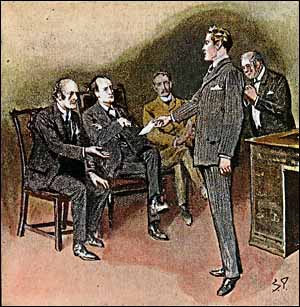 In “The Man with the Twisted Lip,” Holmes advises: “…it is
better to learn wisdom late than never to learn it at all.” And the three
students we find featured in the story of the same name (“The Three Students”)
are no longer children, but they are still quite young in the way of most
university or college students – convinced of their own experience and
maturity, which only serves to emphasize how inexperienced and immature they
really are. Indeed, Giles Gilchrist has managed to surreptitiously obtain an
advance look at the exam, and in doing so has committed a youthful blunder, a
rather common one, in fact – Gilchrist is not, for example, robbing a bank by tunneling beneath it while his employer copies an encyclopedia by hand. And his
actions ultimately harm no one but himself. His decision is ill-advised and he
is suitably remorseful. For his part Holmes reacts with a proportionate level
of concern: “…it is human to err, and at least no one can accuse you of being a
callous criminal…For once you have fallen low. Let us see, in the future,
how high you can rise.” The word future speaks to what is fundamentally
at stake in the story – both for Gilchrist and in terms of the lesson that
Holmes imparts. The story concludes with Gilchrist revealing his decision to join
the Rhodesian police and with that pronouncement, there is a glimpse of a
future where he might apply the lesson he learned firsthand from Sherlock
Holmes – a lesson about leniency and second chances. This is, of course, nearly
the exact same lesson that Holmes imparts to James Ryder in “The Blue Carbuncle” – a man whose desperate concern for what his parents are going to say when
they hear about this, harkens back to
an uncomfortable moment in almost everyone’s formative years. Furthermore,
Holmes’s ability to intuit Ryder’s eventual fate – should he have ended up in
prison – demonstrates the same empathetic streak he showed to Gilchrist.
The manner in which Holmes speaks to Gilchrist could be
described as “fatherly,” perhaps, although that specific description is never
given explicitly in the text of “The Three Students.” In fact, the story, “The Noble Bachelor,” is the only one to feature this particularly telling
descriptor – one suggestive of a patriarchal relationship. In relating to Dr.
Watson how he found the secretly married Mr. and Mrs. Moulton, he says, “I
ventured to give them some paternal advice and to point out to
them that it would be better in every way that they should make their position
a little clearer both to the general public and to Lord St. Simon in
particular.” Hatty Doran is no longer quite a child either – in the strictest
sense – but she is, by Lord St. Simon’s own description: “wild and free,
unfettered by any sort of traditions”; he also uses the words, “impetuous” and “volcanic.”
And so she is a young woman, childish if no longer a child, and like Gilchrist
(and Ryder), she has made an impulsive decision that she would rather her
father never learn of – as unlikely as that might be. And it is the word paternal
that speaks to Holmes’s view of this young bride – who is also likely to soon be a young mother. Holmes has a view to a future full of
little Moultons, with whom their mother can share the valuable lesson of a how
a truth, no matter how painful, is better than a lifetime of uncertainties. And
the fatherly advice that Holmes bestowed to her and her husband is not unlike
that he which imparts in “The Yellow Face”: “Any truth is better than
indefinite doubt.”
In “The Man with the Twisted Lip,” Holmes advises: “…it is
better to learn wisdom late than never to learn it at all.” And the three
students we find featured in the story of the same name (“The Three Students”)
are no longer children, but they are still quite young in the way of most
university or college students – convinced of their own experience and
maturity, which only serves to emphasize how inexperienced and immature they
really are. Indeed, Giles Gilchrist has managed to surreptitiously obtain an
advance look at the exam, and in doing so has committed a youthful blunder, a
rather common one, in fact – Gilchrist is not, for example, robbing a bank by tunneling beneath it while his employer copies an encyclopedia by hand. And his
actions ultimately harm no one but himself. His decision is ill-advised and he
is suitably remorseful. For his part Holmes reacts with a proportionate level
of concern: “…it is human to err, and at least no one can accuse you of being a
callous criminal…For once you have fallen low. Let us see, in the future,
how high you can rise.” The word future speaks to what is fundamentally
at stake in the story – both for Gilchrist and in terms of the lesson that
Holmes imparts. The story concludes with Gilchrist revealing his decision to join
the Rhodesian police and with that pronouncement, there is a glimpse of a
future where he might apply the lesson he learned firsthand from Sherlock
Holmes – a lesson about leniency and second chances. This is, of course, nearly
the exact same lesson that Holmes imparts to James Ryder in “The Blue Carbuncle” – a man whose desperate concern for what his parents are going to say when
they hear about this, harkens back to
an uncomfortable moment in almost everyone’s formative years. Furthermore,
Holmes’s ability to intuit Ryder’s eventual fate – should he have ended up in
prison – demonstrates the same empathetic streak he showed to Gilchrist.
The manner in which Holmes speaks to Gilchrist could be
described as “fatherly,” perhaps, although that specific description is never
given explicitly in the text of “The Three Students.” In fact, the story, “The Noble Bachelor,” is the only one to feature this particularly telling
descriptor – one suggestive of a patriarchal relationship. In relating to Dr.
Watson how he found the secretly married Mr. and Mrs. Moulton, he says, “I
ventured to give them some paternal advice and to point out to
them that it would be better in every way that they should make their position
a little clearer both to the general public and to Lord St. Simon in
particular.” Hatty Doran is no longer quite a child either – in the strictest
sense – but she is, by Lord St. Simon’s own description: “wild and free,
unfettered by any sort of traditions”; he also uses the words, “impetuous” and “volcanic.”
And so she is a young woman, childish if no longer a child, and like Gilchrist
(and Ryder), she has made an impulsive decision that she would rather her
father never learn of – as unlikely as that might be. And it is the word paternal
that speaks to Holmes’s view of this young bride – who is also likely to soon be a young mother. Holmes has a view to a future full of
little Moultons, with whom their mother can share the valuable lesson of a how
a truth, no matter how painful, is better than a lifetime of uncertainties. And
the fatherly advice that Holmes bestowed to her and her husband is not unlike
that he which imparts in “The Yellow Face”: “Any truth is better than
indefinite doubt.”
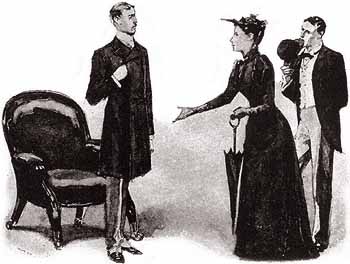
Finally, in “The Illustrious Client,” the reader finds
Violet de Merville. Although no specifics about her age are given, she is
referred to as “young” no less than five times throughout the course of the
story. Violet has also found herself at a
rather childish impasse – much like Gilchrist’s academic dishonesty or Mrs.
Moulton’s clandestine union – but Violet is stubborn in the way of so many young
women and men who find themselves newly in love and unreceptive to the words of
parents, who know that their child’s new paramour is just no good – whether it
is because he rides a motorcycle, was caught smoking under the bleachers, or
has a documented history of murdering his wives. In any event, Holmes confesses
to Watson, somewhat shockingly: “I thought of her for the moment as I would
have thought of a daughter of my own.” The word daughter places emphasis
on a family relationship and clearly indicates and stresses Violet’s gender. Holmes has given advice to young
women before – and furthermore, he is used to having young women disregard that
advice (having already dealt with another Violet – Miss Hunter – in 1890). He already
knows that his next steps with Miss de Merville will have to be resolute, dramatic,
and probably somewhat unpleasant. And so when Holmes says, “All my hot words
could not bring one tinge of colour to those ivory cheeks or one gleam of
emotion to those abstracted eyes” – it brings to mind his advice from “A Case of Identity”: “If I tell her she will not believe me. You may remember the old
Persian saying, ‘There is danger for him who taketh the tiger cub, and danger
also for whoso snatches a delusion from a woman.’ There is as much sense in
Hafiz as in Horace, and as much knowledge of the world.”
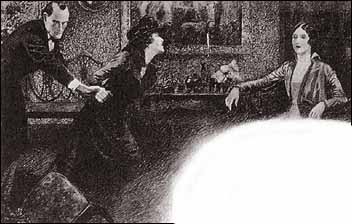
As we know, Holmes was never pleased with Watson’s efforts
to preserve his methods for posterity – often stating that his Boswell’s
stories were too romantic or florid for his taste. So, Sherlock Holmes never
saw his deductive methods put to
paper in a way that was precisely to his liking – his oft-mentioned monographs
only partially served this purpose and cannot be considered a complete
compendium of Holmesian investigation. And for the purposes of the Canon, Holmes
died unmarried and childless (my apologies to Mr. Baring-Gould), and he speaks
of his own family in an absent, off-hand manner as if it were a footnote in one
of those monographs. Perhaps Holmes chose young adults, rather than small
children (of whom he was also famously fond) because young adults had the most
potential for an immediate payout on his lessons. The canonical characters
mentioned just now were all just on the cusp of a significant age-related milestone
– a career, a marriage, children. These characters were all just old enough to
really appreciate the enormity of Holmes’s lesson (if not the finer details of
his methods), but also young enough for the lesson to still have a real impact.
There was still time for the lesson to sink into their skin and linger there,
rather than be brushed off as just one more lecture in a collection of a
lifetime of experiences.
But ultimately what was at stake was the lesson, and as has hopefully been demonstrated, that lesson was shared, and Sherlock Holmes once again succeeded. Young people are mere random sketches of both children and adults – close to both roles without fully encompassing either. They are able to pick and choose details, disregarding irrelevancies, until their self-portrait is finally complete. Just as the lessons Holmes conveyed to them were mere random sketches of lessons he had outlined in previous stories – rough mirror images, cleverly concealing their significance, as well as their potential for so much more.
oOo
“Better Holmes & Gardens” now has its own Facebook
page. Join by “Liking” the page here,
and receive all the latest updates, news, and Sherlockian tidbits.
 As part of an ongoing project on my Twitter feed, I'm delivering stories from the Sherlock Holmes canon in tiny installments of 140 characters or less. I recently finished up "The Adventure of the Abbey Grange," which finds Sherlock Holmes acting as judge, and Dr. Watson in the role of jury (but the executioner is conspicuously absent).
As part of an ongoing project on my Twitter feed, I'm delivering stories from the Sherlock Holmes canon in tiny installments of 140 characters or less. I recently finished up "The Adventure of the Abbey Grange," which finds Sherlock Holmes acting as judge, and Dr. Watson in the role of jury (but the executioner is conspicuously absent).



